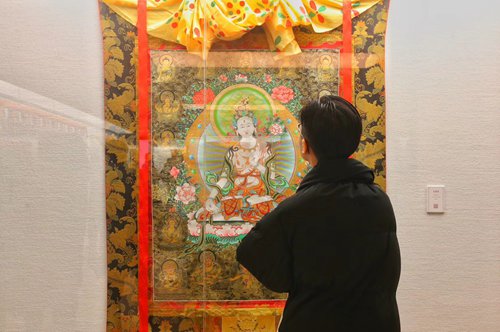
A Tibetan thangka on display at the NAMOC (Photo/Courtesy of Yang Zi)
With spring right around the corner, many young travelers have already started planning hiking or cycling trips through the Tibet Autonomous Region and other regions where Tibetans reside so they may enjoy the unique art and culture of this ethnic minority group.
Among all the different Tibetan art forms, the art of thangka is one of the most representative. Fortunately for those residing or traveling in Beijing who are eager to learn more about this art form, they don't need to travel all the way to Southwest China to enjoy thangka as an exhibition of this traditional art is currently being held at the National Art Museum of China.
Kicked off on January 19 at the museum's Hall 10, 11 and 18, The Painting the Snowland - Dreaming with Ingenuity: Exhibition of Elaborate Thangka Paintings of Qinghai is scheduled to come to an end on January 28.
History of an art form
As a symbol of Tibetan art, thangka at their core are paintings on cotton, silk and even human skin. When it comes to content, these thangka paintings cover a wide range of themes and elements, including Buddhist deities, masters, mandala and sometimes depictions of traditional stories. To look at a thangka is like opening an encyclopedia as one can get a glimpse of Tibetan history as well as many different Buddhas and rituals.
"The art of thangka is based on Tibetan history and religion. There are also elements of nature when it records the real scenery and locals of the Qinghai-Tibet Plateau, conveying the beauty of the region to all viewers," Wu Weishan, the director of National Art Museum of China said at a media conference.
In the Tibetan language, thangka means "scroll painting." Originally used for instructing monastic students during their personal meditations, thangka evolved into a specific format of painting. When creating a thangka, a central deity usually is placed in the middle or the most prominent position of the picture, while other secondary deities and attendants are arranged around the central figure, always following the order of the lineage of that particular school of Tibetan Buddhism. Other topics such as narrative stories appear sometimes in thangka paintings as well to provide an overview of the road to Buddhahood, although they are not that common. For example, some thangka depict the life of the Sakyamuni Buddha, who decided to give up his noble lifestyle to devote himself to meditative studies. After becoming the first Buddha, he founded Buddhism and started to teach others. The process of his transformation from a person to Buddha is depicted in many legendary stories, which are shown in thangka or mural paintings.

Form and function
Though thangka have deep connections to Tibetan culture, one doesn't need to be an expert to appreciate their beauty.
"I'm not very acquainted with this type of art," Liu Zhimin, a student from the University of Science and Technology of China, told the Global Times while appreciating a huge thangka at the exhibition.
"I major in landscape architecture, which I think may be connected in some way to thangka paintings, so I am here to figure that out," she explained.
"It really amazes me because it takes eight days to finish just one thangka, and the artistic effects are really well done."
Since traditionally thangka are used as teaching tools. They contain visual messages that relate to the stories of Buddhist masters. To become a Buddha, one must experience the process of enlightenment. When a Buddhist practitioner is on their path to enlightenment, thangka are used to lead the practitioner during meditation. By visualizing themselves as being that deity, they thereby internalize that Buddha's qualities.
However, as many thangkas nowadays are produced for commercial use, only a few are created to suit their original purpose. As the reputation of this art form increases, artists throughout China are starting to copy and create their own versions of thangka paintings.
With this introduction of various kinds of artists, the quality of thangka has been difficult to maintain.
"A good thangka is not just a copy of the old form, there must be something new," Luo Wenhua, the director of the Research Centre for Tibetan Buddhist Heritage at the Palace Museum, told the Global Times.
"I feel that innovation is the most important factor in thangka art. Innovation is a kind of exploration that artists must keep doing when painting a thangka. They cannot just simply slap some bright colors or a large amount of gold paint on a canvas and call it a thangka."


















































